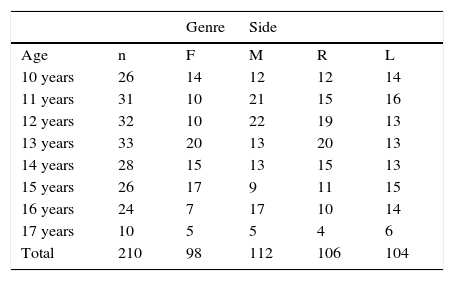Few studies have evaluated the radiologic characteristics of the development of the anterior tibial tuberosity. This study aimed to evaluate the radiologic characteristics of the anterior tibial tuberosity in a pediatric population broken down into age groups.
Material and methodsWe assessed 210 plain-film X-rays of the knee from patients aged from 10 to 17 years, divided into groups according to age and sex, for the presence of ossification of the anterior tibial tuberosity, the distance between the anterior tibial tuberosity and the metaphysis, and fusion with the epiphysis.
ResultsAt 10 years of age, the anterior tibial tuberosity was ossified in 50% of the girls but in only 25% of the boys. In all the girls, the anterior tibial tuberosity was ossified at 11 years, fusion of the anterior tibial tuberosity with the epiphysis had started at 12 years, and fusion was complete by 17 years. In boys, the process is delayed by one year compared to girls. A single center of ossification was found in all cases.
ConclusionThe ossification of the anterior tibial tuberosity starts distally, then the proximal part fuses with the rest of the epiphysis, and finally the distal part fuses with the tibia. The results of this study help enable a better analysis of the anterior tibial tuberosity in cases of knee pain.
Existen pocos estudios que evalúen las características radiológicas del desarrollo de la tuberosidad tibial anterior (TTA). El presente trabajo tiene por objeto evaluar las características radiológicas de la TTA en una población pediátrica de acuerdo a grupos de edad.
Material y métodosEs un estudio llevado a cabo en 210 radiografías de rodillas de pacientes entre los 10 y 17 años, que fueron divididos por grupos de edad y sexo. Se evaluaron la presencia de osificación de la TTA, la distancia de esta a la metáfisis y la fusión con la epífisis.
ResultadosA los 10 años de edad, la TTA estaba osificada en el 50% de las mujeres y solo en el 25% de los hombres. A los 11 años todas las mujeres tenían osificada la TTA, a los 12 tenían fusión de la TTA y con la epífisis, y a los 17 años la fusión era completa. En los hombres este proceso se produce un año más tarde que en las mujeres. En todos los casos se encontró un solo núcleo de osificación.
ConclusiónLa osificación de la TTA se inicia distalmente, posteriormente se fusiona su parte proximal con el resto de la epífisis y finalmente se fusiona en su parte distal a la tibia. Este estudio ayuda a un mejor análisis de la TTA cuando nos enfrentamos a un dolor de rodilla.
Artículo
Comprando el artículo el PDF del mismo podrá ser descargado
Precio 19,34 €
Comprar ahora














